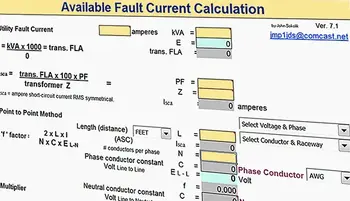Maximum Fault Current Calculation Explained

Maximum Fault Current Calculation
In order to determine maximum fault current in either a single-phase circuit or a three-phase circuit, you need to perform a calculation involving impedance. Total impedance is the sum of the impedances of the conductors from the origin of the installation to the circuit under consideration. For single phase circuits, the maximum fault current is between the phase and the neutral and in three-phase circuits the maximum fault current is when all phases are shorted (symmetrical current). The total impedance is that with operating temperature 20 degrees C (lower temperature means lower resistance).
Power System Protection Courses
Short Circuit Study & Protective Device Coordination
Arc Flash Analysis/Study - IEEE 1584 Update
Maximum fault current calculations should be performed at all critical points in the system including:
- Service entrance equipment
- Transfer switches
- Panelboards
- Load centers
- Motor control centers
- Disconnects
- Motor starters
Normally, fault current studies involve calculating a bolted three-phase fault condition. This can be characterized as all three phases “bolted” together to create a zero impedance connection. This establishes a “worst case” (highest current) condition that results in maximum three- phase thermal and mechanical stress in the system.
From this calculation, other fault condition types can be approximated. This “worst case” condition should be used for interrupting rating, component protection, “Table” method for determining PPE per NFPA 70E and selective coordination.
Arc flash hazard analysis calculations should consider both maximum and minimum fault current calculations. Incident energy depends upon current and time. For lower arcing current values, clearing times could be longer than those for higher arcing current values, which could result in higher incident energy values. Therefore, an arc flash analysis must consider both spectrum of available fault current for calculating arcing currents, which are then compared with OCPD TCC curves to determine clearing times.
There are several variables in a distribution system affecting calculated bolted three-phase fault currents. Variable values applicable for the specific application analysis must be selected. The point-to-point method presented in this section includes several adjustment factors given in notes and footnotes that can be applied, and that will affect results. Some of the parameters that must be considered include utility source fault current, motor contribution, transformer percent impedance tolerance and voltage variance.
In most situations, the utility source(s) or on-site energy sources (such as generators) are the major fault current contributors. The point-to- point method includes steps and examples that assume an infinite available fault current from the utility source. Generally, this is a good assumption for highest, worst case conditions since the property owner has no control over the utility’s system and future utility changes. In many cases, a large increase in the utility available fault current does not increase the building system’s fault current a great deal on the secondary of the service transformer. However, there are cases where the actual utility medium voltage available fault current provides a more accurate fault current assessment (minimum bolted fault current conditions) that may be needed to assess arc flash hazards.
When motors are in the system, motor fault current contribution is also a very important factor to include in any fault current analysis. When a fault occurs, motor contribution adds to the fault current magnitude, with running motors contributing four to six times their normal full load current. Series rated combinations can’t be used in specific situations due to motor fault current contributions.
For short time duration capacitor discharge currents, certain IEEE (Institute of Electrical and Electronic Engineers) publications detail how to calculate these currents if they are substantial.
Read Other Electrical System Protection Articles
Transformer Protection Explained
On-Site Training
Interested in cost effective, professional on-site electrical training?
We can present an Electrical Training Course to your electrical engineering and maintenance staff, on your premises, tailored to your specific equipment and requirements. Click on the link below to request a Free quotation.
EF PARTNER MEDIA
Product Showcases
Shared Media
















